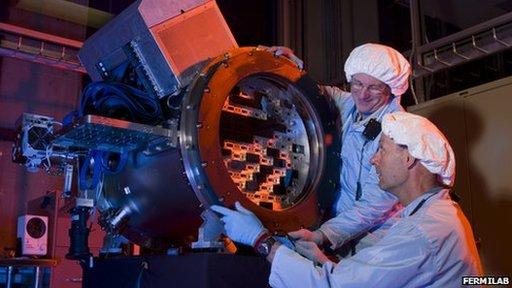Getting the measure of dark energy
- Published
- comments

Scientists at UCL are putting the finishing touches to the Dark Energy Camera, the largest and highest resolution camera ever built which will scan deep space looking for evidence of dark energy, the mysterious force thought to be driving the expansion of the universe.
Even as Adam Riess was regaling the media with an amusing, self-depreciating, anecdote about his early morning wake-up call from Oslo, deep in the bowels of UCL's Department of Physics and Astronomy researchers were putting the finishing touches to a camera that could finally shed some light on the discovery that won him the Nobel Prize for Physics.
Riess shared this year's prize with with fellow American Saul Perlmutter and the Australian Brian Schmidt for the discovery, back in 1998, that the expansion of the Universe is accelerating. But exactly what's driving that expansion - the force responsible for pulling the Universe apart, and for want of a better description, dubbed dark energy - remains a mystery.Getting the measure of dark energy
When it's bolted onto the Blanco Telescope at the Cerro Tolodo Observatory in Chile next month the 570-megapixel Dark Energy Camera will survey some 300 million galaxies in the southern sky, measuring the speed at which they are moving apart with phenomenal accuracy, and giving the best description yet of the accelerating expansion of the Universe.
University College London's part in the project has been to design and build an optical corrector for the camera - an array of five massive lenses that sit at the primary focus of the camera.
"We need very accurate high resolution images over a very wide field for the Dark Energy Survey" says Dr Peter Doel from UCL's Optical Science Laboratory. "So these lenses have to be aligned to within 50 microns. That's half the thickness of a sheet of paper."
The Dark Energy Survey will adopt a series of different, but complimentary, techniques to study the effects of dark energy: it will analyse the distribution of galaxies and clusters of galaxies across the southern sky; study the effect of weak gravitational lensing, as light emanating from distant stars is bent and distorted as it travels across deep space; and measure the brightness of 3,000 type 1a supernovae - the exploding stars used as "standard candles" by cosmologists to calculate astronomical distances.
The point, according to Professor Ofer Lahav, who's the lead investigator for the UK consortium involved in the Dark Energy Survey, is that the nature of all these phenomena is heavily influenced by the properties of dark energy.
"A universe with or without dark energy would have a different pattern of galaxies, a different number of clusters. The distortion of light, and the way supernovae appear would be different. So we're looking at this big chunk of the Universe as a way of finding evidence for dark energy and characterising its nature."
Listening to Ofer Lahav talk about dark energy I'm struck that this is what it must have been like to hear Isaac Newton describe gravity in the 1680s. And dark energy may turn out to be almost the mirror opposite of gravity - a repulsive rather than an attractive force, and one that strengthens with distance rather than weakening.
We should have a clearer idea when the results from the Dark Energy Survey and its massive 570-megapixel camera are published in five years' time.